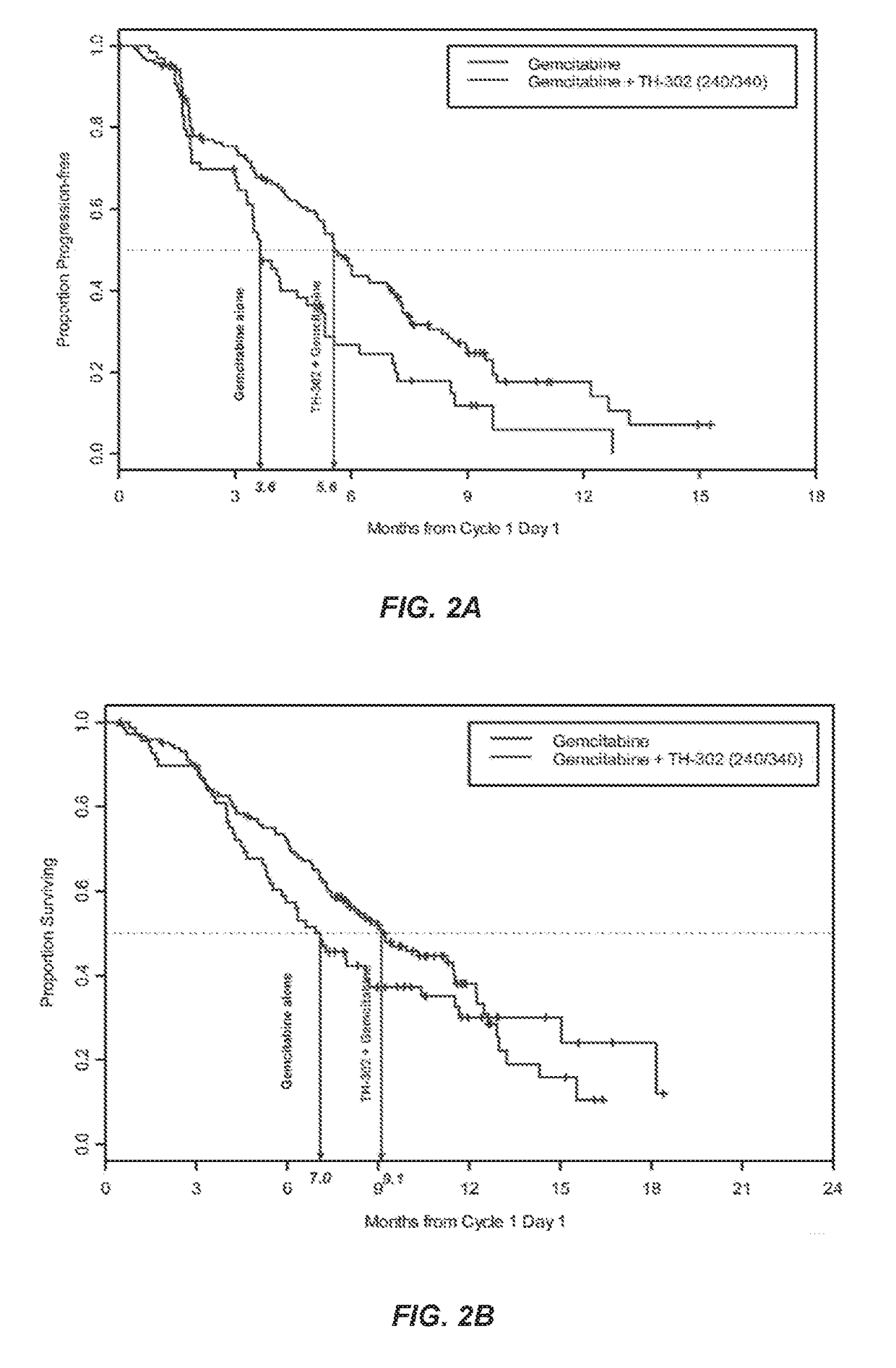Treatment of cancer
a cancer and cancer technology, applied in the field of cancer treatment, can solve the problems of adverse side effects of patients, difficult to kill cancer cells without damaging or killing normal cells, so as to improve the tolerability of the prodrug, improve the efficacy of treatment and quality of life, and reduce appetite.
- Summary
- Abstract
- Description
- Claims
- Application Information
AI Technical Summary
Benefits of technology
Problems solved by technology
Method used
Image
Examples
example 1
[0126]A Phase 1 / 2, multicenter, dose-escalation study was conducted using a classic dose escalation design followed by a dose expansion to demonstrate the efficacy and determine the safety of TH-302 when administered in combination with gemcitabine. The initial dose of TH-302 was 240 mg / m2. TH-302 was administered by intravenous (IV) infusion over 30 minutes on Days 1, 8, and 15 of a 28-day (4 week) cycle (Arm A). Gemcitabine was administered 2 h after the TH-302 infusion was completed. The starting doses of gemcitabine remained fixed according to the approved dose listed in the respective product labeling. The treatment regimen, dose, schedule and cycle length of gemcitabine was as follows. Gemcitabine was administered IV at 1,000 mg / m2 IV over 30 minutes on Days 1, 8, and 15 of each 28-day cycle. TH-302 was administered as above on Days 1, 8, and 15 of each 28-day cycle.
[0127]The dose was initiated at 240 mg / m2 and dose escalation was then continued with 40% increases from the pre...
example 2
[0129]In a separate Phase 2b trial, TH-302 was administered intravenously for 30 to 60 minutes on days 1, 8 and 15 of a 28 day cycle at either 240 mg / m2 or 340 mg / m2. Gemcitabine was dosed according to its package insert on days 1, 8 and 15 of a 28 day cycle. The 214 patient randomized controlled Phase 2b clinical trial compared the efficacy and safety of these two doses (240 mg / m2 and 340 mg / m2) of TH-302 in combination with gemcitabine to gemcitabine alone in patients with first-line advanced pancreatic cancer. The trial achieved its primary endpoint, with a 63% improvement in progression free survival. Furthermore, secondary efficacy endpoints also trended in favor of the gemcitabine plus TH-302 combination arms compared to the gemcitabine alone treatment arm control. The trial thus demonstrated that TH-302 confers tangible benefit to patients with aggressive and difficult to treat pancreatic cancer.
[0130]The clinical trial was conducted as a multi-center, randomized, controlled,...
example 3
[0135]This example is an update of the open-label, multicenter, randomized, Phase 2b study (NCT01144455) of two dose levels of TH-302 in combination with gemcitabine vs gemcitabine alone. The update was conducted in September 2012 and including a further follow-up of the data provided in Example 2.
[0136]Patients were stratified according to their disease stage (unresectable locally advanced vs distant metastases) and randomized as shown in FIG. 4. The treatments were administered intravenously in sequential 30 to 60-minute infusions (TH-302 followed by gemcitabine) on days 1, 8, and 15 of a 28-day cycle. Unless patients experienced progressive disease (PD) or unacceptable toxicity, they could continue to receive treatment beyond 6 cycles if considered clinically beneficial. Patients initially randomized to G alone could cross-over after PD and be randomized to one of the two G+T arms.
[0137]Key eligibility criteria included histologically or cytologically confirmed locally advanced o...
PUM
| Property | Measurement | Unit |
|---|---|---|
| concentration | aaaaa | aaaaa |
| concentration | aaaaa | aaaaa |
| concentration | aaaaa | aaaaa |
Abstract
Description
Claims
Application Information
 Login to View More
Login to View More - R&D Engineer
- R&D Manager
- IP Professional
- Industry Leading Data Capabilities
- Powerful AI technology
- Patent DNA Extraction
Browse by: Latest US Patents, China's latest patents, Technical Efficacy Thesaurus, Application Domain, Technology Topic, Popular Technical Reports.
© 2024 PatSnap. All rights reserved.Legal|Privacy policy|Modern Slavery Act Transparency Statement|Sitemap|About US| Contact US: help@patsnap.com










